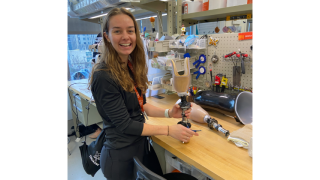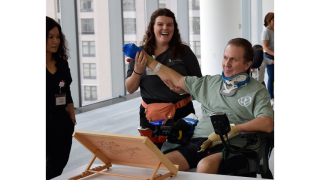Sometimes people with certain medical conditions can require changes to their diets that affect the amount of liquids they take in every day. This type of diet change is called a “Fluid Restriction”.
Body
Fluid Restriction means that you can only have a certain amount of liquid each day.
If a person needs to change or restrict the liquids that they are taking in, their doctor or healthcare provider will let them know. Their doctor or healthcare provider will also tell them the reason for the Fluid Restriction and how much liquid they can drink per day. Since water is essential for all body functions, there is a delicate balance to maintain enough hydration. It is important to work with your healthcare provider and always feel free to share your questions or concerns about changes to your diet and your general care.
Below are some frequently asked questions about Fluid Restriction diets and tips for managing your daily intake of liquids:
Who may require a fluid restriction diet?
Although there are many different circumstances where a person may be prescribed to follow a Fluid Restriction diet, some of the more common medical conditions and associated symptoms requiring fluid restriction are listed below:
- Heart problems, including Congestive Heart Failure (CHF)
- Kidney problems, including End Stage Renal Disease (ESRD) and people undergoing dialysis
- Endocrine System and Adrenal gland disorders, including Adrenal Insufficiency
- Conditions that cause the release of stress hormones
- Treatment with medications called corticosteroids
- Low levels of Sodium in your body also known as Hyponatremia

Signs and Symptoms of Fluid Overload (too much fluid in your body)
Although your healthcare provider will often examine you and test your blood, it is also very important to take charge of your health and monitor yourself. Watch out for:
- Swelling of the hands, ankles, and/or feet
- Increased size of the veins in your neck
- Weight gain
- Rapid heartbeat
- Increased blood pressure
- Increased urination
- Changes in mental status
Treatment Considerations and Tips
In addition to following a low-sodium diet and taking diuretics (“water pills”) as prescribed by your healthcare provider, a Fluid Restriction can help to achieve your health goals. Depending on the fluid limit outlined for your condition and prescribed by your healthcare provider the following are strategies to help manage your daily fluid intake:
- Plan out the amount of liquid you will have during the day: how much will you drink to take your medications? How much will you drink with your meals? In order to decide what works best for you, it is helpful to sit down with a nutritionist or nurse and talk with friends and family who may be able to support you. By identifying preferred drinks and your drinking pattern, you will more easily be able to decide how to adjust to your Fluid Restriction.
- Use small cups: using a small cup can give the perception of a full glass.
- Use a designated container: some people find it helpful to measure out their daily fluid allowance in one large container and drink only from there throughout the day.
- Maintain good oral care: by brushing your teeth after meals, rinsing with alcohol free mouthwash, chewing sugarless gum or sucking on hard candy you may be able to decrease dry mouth and urges to drink.
- Avoid foods with high levels of sodium (salt): these types of foods will increase your thirst;
- Weigh yourself daily: it is important to use the same scale around the same time each day to get the most accurate information and report any weight gain of 2 pounds or more in one day to your physician;
- Record your fluid intake: recording your fluid intake will help make sure that you are not taking in more fluids than expected. It is a good idea to write this information on a tracking log/calendar (a sample is attached).
- You will need to learn the number of cc’s (cubic centimeters) or ml’s (milliliters) in common servings. Some sample measurements are included below.
- Soups, food prepared with water, and semi-solids such as popsicles, and jello, should count toward your total daily fluid intake.
Helpful Tips to Remember:
- Food that melts at room temperature is considered a liquid.
- Include liquid amounts when taking your medications.
- Maintain a daily log and track all fluid intake.
- Satisfy thirst by sucking on an ice cube, hard candy, chewing gum, or rinsing mouth with water--but do not swallow.
Fluid measurements
1 ounce = 30 cc
8 ounces = 240 cc
1 cup = 8 ounces = 240 cc
Sample measurements
Coffee cup = 200 cc
Clear glass = 240 cc
Milk carton = 240 cc
Small milk carton = 120 cc
Juice, Jell-o or ice cream cup = 120 cc
Soup bowl = 160 cc
Popsicle half = 40 cc
Remember: every person and their healthcare needs are unique.
The above information is meant to be a general guide.
Make sure to consult with your healthcare team to ensure that you do what is best for your particular condition in order to meet your goals.
Sample: Fluid Intake Tracking Log
| Date | Time | Type of Fluid | Amount |
| Total |

You might also be interested in:
Complications: Swelling or Edema and Contractures
References: http:www.americanheart.org
LeMone, P., Burke, K., and Bauldoff, G. 2011. Medical Surgical Nursing: Critical Thinking in Patient Care. 5th edition. Boston,MA: Pearson Publishers.
Smith, S., Duell, D., and Martin, B. 2011. Clinical Nursing Skills: Basic to Advanced Skills. 7th edition. Prentice Hall. New Jersey.
glass of water Photo by Joseph Greve on Unsplash
Mn Lake photo by Lori Snyder, Medical Librarian.
Body
This content is for informational purposes only and may not be comprehensive. Information contained does not imply an endorsement from Shirley Ryan AbilityLab, and does not replace the advice of a qualified healthcare professional. See here for further details. © Shirley Ryan AbilityLab (formerly Rehabilitation Institute of Chicago). Henry B. Betts LIFE Center – (312) 238-5433 – https://www.sralab.org/lifecenter.



